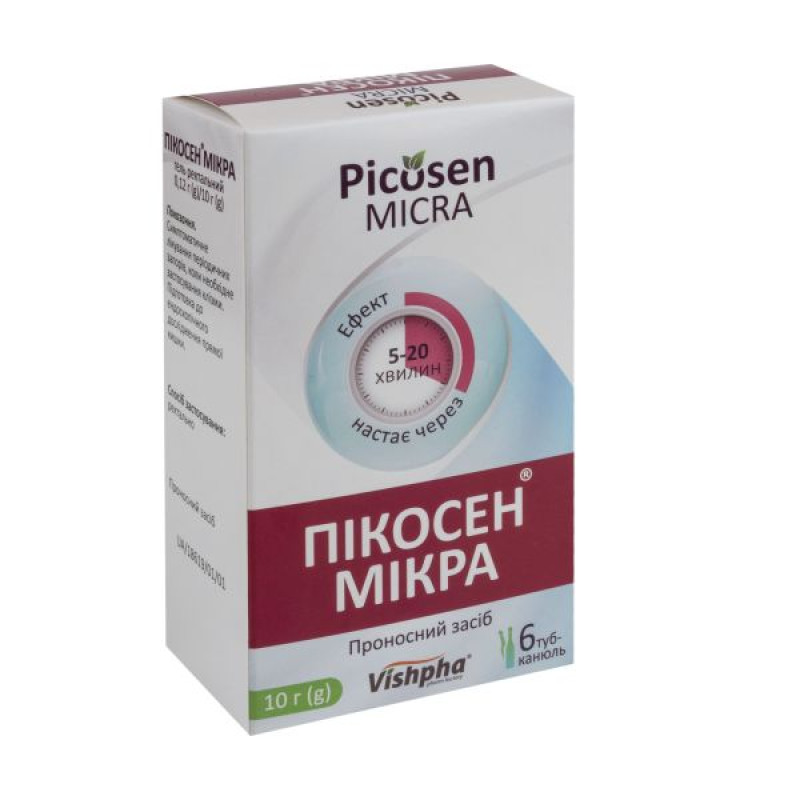Picosen micro rectal gel 0.12g / 10g tube No. 6

Instructions Picosen micro rectal gel 0.12g / 10g tube No. 6
Composition
active ingredient: 1 g of gel contains 12 mg of docusate sodium;
excipients: glycerin, sodium carboxymethylcellulose, purified water.
Dosage form
Rectal gel.
Main physicochemical properties: colorless opalescent liquid with a liquid gel consistency.
Pharmacotherapeutic group
Laxatives. Enemas.
ATX code A06A G10.
Pharmacological properties
Pharmacodynamics
The product helps soften and facilitate the movement of stool, stimulates the defecation reflex.
Docusate sodium promotes water retention in fecal masses, which in turn increases their volume. The onset of effect is 5–20 minutes after administration.
PICOSEN® MICRA acts locally in the rectum.
Pharmacokinetics
Minimal absorption cannot be excluded even with rectal administration.
Indication
Symptomatic treatment of intermittent constipation when enemas are necessary. Preparation for endoscopic examination of the rectum.
Contraindication
Hypersensitivity to any of the components of the drug.
Intestinal obstruction, hemorrhoids, anal fissures, anal bleeding, inflammatory bowel disease, abdominal pain, nausea, vomiting, ulcerative colitis.
Special safety precautions
Like other laxatives, PICOSEN® MICRA should not be used continuously. Prolonged use may cause intestinal atony and hypokalemia. With prolonged use, there is a risk of developing addiction with the need for regular use of the laxative and increasing its dose. And in the event of discontinuation of the drug, constipation may develop. Drug treatment of constipation should only be an addition to hygienic and dietary treatment:
Enriching the diet with plant fibers and drinks; advice on physical activity and retraining in bowel movements.
Interaction with other medicinal products and other types of interactions
Caution should be exercised when used with drugs that cause hypokalemia, which can lead to cardiac arrhythmias (including torsades de pointes) and increased toxicity of some drugs, such as digoxin. Drugs that cause hypokalemia: hypokalemic diuretics, alone or in combination, stimulant laxatives, glucocorticoids, tetracosactide, and amphotericin B (intravenously).
PICOSEN® MICRA may enhance the absorption of other drugs. Docusate sodium may enhance the hepatotoxicity of other drugs.
Application features
Long-term use is not recommended (if 1–2 single applications are ineffective, treatment tactics should be reviewed).
The use of the drug is unacceptable for ulcerative colitis.
The medicine contains glycerin, which may have a mild laxative effect.
Ability to influence reaction speed when driving vehicles or other mechanisms
Unknown.
Use during pregnancy or breastfeeding
Pregnancy
There are no adequate data from the use of docusate enemas or oral docusate in pregnant women. Animal studies of oral docusate are insufficient with respect to effects on pregnancy and embryonal/fetal development.
The potential risk to humans is unknown. Since minimal systemic absorption cannot be excluded with rectal administration, PICOSEN® MICRA should be used during pregnancy only if the benefits outweigh the risks.
Breast-feeding
It is not known whether docusate is excreted in human milk. Animal studies have shown excretion of docusate and its metabolites in breast milk when administered systemically. A decision on whether to continue/discontinue breast-feeding or to continue/discontinue therapy with PICOSEN® MICRA should be made taking into account the benefit of breast-feeding for the child and the benefit of therapy with PICOSEN® MICRA for the woman.
Method of administration and doses
Apply rectally.
The gel is introduced into the rectum using a cannula tube (microclema). Remove the protective cap. Insert the pointed part of the cannula tube into the rectum and squeeze out the contents of the entire tube. Remove the cannula tube without loosening the compression.
If necessary, a drop of gel can be used to lubricate the cannula.
Symptomatic treatment of constipation: 1 tube-cannula per day.
Preparation for endoscopic examination of the rectum: 1 tube-cannula 5–20 minutes before the planned time of defecation.
Children
Do not use the medicine in children under 18 years of age.
Overdose
May lead to increased side effects.
Adverse reactions
The frequency of adverse reactions is defined as follows: very common (≥ 1/10), common (≥ 1/100 to < 1/10), uncommon (≥ 1/1000 to < 1/100), rare (≥ 1/10,000 to < 1/1000), very rare (< 1/10,000), frequency unknown (cannot be estimated from the available data).
The presence of glycerin can lead to indigestion and diarrhea.
Hepatobiliary: Cases of hepatotoxicity have been reported with oral administration of docusate sodium, especially in patients concomitantly taking other laxatives.
Skin and subcutaneous tissue disorders: frequency unknown - urticaria.
Expiration date
3 years.
Storage conditions
Store at a temperature not exceeding 25 ° C. Keep out of the reach of children.
Packaging
10 g in a tube-cannula; 6 tubes-cannula in a pack.
Vacation category
Without a prescription.
Producer
LLC "SKP "Pharmaceutical Factory".
Location of the manufacturer and its business address
Ukraine, 12430, Zhytomyr region, Zhytomyr district, Stanyshivka village, Koroleva st., bldg. 4
There are no reviews for this product.
There are no reviews for this product, be the first to leave your review.
No questions about this product, be the first and ask your question.








